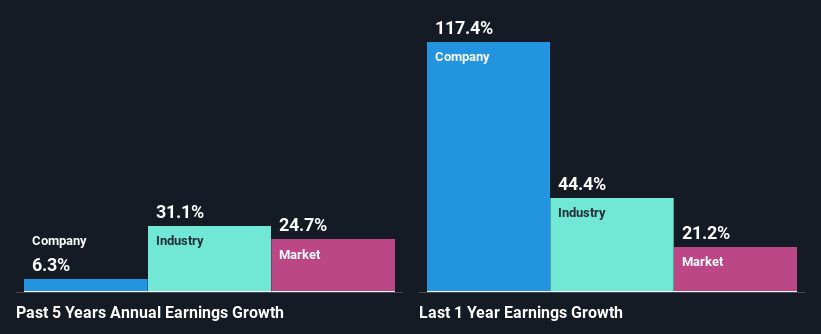- India
- /
- Construction
- /
- NSEI:INDIANHUME
Declining Stock and Decent Financials: Is The Market Wrong About The Indian Hume Pipe Company Limited (NSE:INDIANHUME)?

With its stock down 29% over the past three months, it is easy to disregard Indian Hume Pipe (NSE:INDIANHUME). But if you pay close attention, you might find that its key financial indicators look quite decent, which could mean that the stock could potentially rise in the long-term given how markets usually reward more resilient long-term fundamentals. In this article, we decided to focus on Indian Hume Pipe's ROE.
ROE or return on equity is a useful tool to assess how effectively a company can generate returns on the investment it received from its shareholders. Simply put, it is used to assess the profitability of a company in relation to its equity capital.
View our latest analysis for Indian Hume Pipe
How Do You Calculate Return On Equity?
The formula for return on equity is:
Return on Equity = Net Profit (from continuing operations) ÷ Shareholders' Equity
So, based on the above formula, the ROE for Indian Hume Pipe is:
12% = ₹1.0b ÷ ₹8.7b (Based on the trailing twelve months to September 2024).
The 'return' is the income the business earned over the last year. One way to conceptualize this is that for each ₹1 of shareholders' capital it has, the company made ₹0.12 in profit.
Why Is ROE Important For Earnings Growth?
We have already established that ROE serves as an efficient profit-generating gauge for a company's future earnings. Based on how much of its profits the company chooses to reinvest or "retain", we are then able to evaluate a company's future ability to generate profits. Generally speaking, other things being equal, firms with a high return on equity and profit retention, have a higher growth rate than firms that don’t share these attributes.
A Side By Side comparison of Indian Hume Pipe's Earnings Growth And 12% ROE
On the face of it, Indian Hume Pipe's ROE is not much to talk about. However, its ROE is similar to the industry average of 13%, so we won't completely dismiss the company. On the other hand, Indian Hume Pipe reported a moderate 6.3% net income growth over the past five years. Given the slightly low ROE, it is likely that there could be some other aspects that are driving this growth. For instance, the company has a low payout ratio or is being managed efficiently.
We then compared Indian Hume Pipe's net income growth with the industry and found that the company's growth figure is lower than the average industry growth rate of 31% in the same 5-year period, which is a bit concerning.

Earnings growth is a huge factor in stock valuation. It’s important for an investor to know whether the market has priced in the company's expected earnings growth (or decline). This then helps them determine if the stock is placed for a bright or bleak future. One good indicator of expected earnings growth is the P/E ratio which determines the price the market is willing to pay for a stock based on its earnings prospects. So, you may want to check if Indian Hume Pipe is trading on a high P/E or a low P/E, relative to its industry.
Is Indian Hume Pipe Using Its Retained Earnings Effectively?
In Indian Hume Pipe's case, its respectable earnings growth can probably be explained by its low three-year median payout ratio of 10% (or a retention ratio of 90%), which suggests that the company is investing most of its profits to grow its business.
Moreover, Indian Hume Pipe is determined to keep sharing its profits with shareholders which we infer from its long history of paying a dividend for at least ten years. Looking at the current analyst consensus data, we can see that the company's future payout ratio is expected to rise to 13% over the next three years. Accordingly, the expected increase in the payout ratio explains the expected decline in the company's ROE to 8.1%, over the same period.
Summary
In total, it does look like Indian Hume Pipe has some positive aspects to its business. Namely, its respectable earnings growth, which it achieved due to it retaining most of its profits. However, given the low ROE, investors may not be benefitting from all that reinvestment after all. With that said, on studying the latest analyst forecasts, we found that while the company has seen growth in its past earnings, analysts expect its future earnings to shrink. Are these analysts expectations based on the broad expectations for the industry, or on the company's fundamentals? Click here to be taken to our analyst's forecasts page for the company.
New: AI Stock Screener & Alerts
Our new AI Stock Screener scans the market every day to uncover opportunities.
• Dividend Powerhouses (3%+ Yield)
• Undervalued Small Caps with Insider Buying
• High growth Tech and AI Companies
Or build your own from over 50 metrics.
Have feedback on this article? Concerned about the content? Get in touch with us directly. Alternatively, email editorial-team (at) simplywallst.com.
This article by Simply Wall St is general in nature. We provide commentary based on historical data and analyst forecasts only using an unbiased methodology and our articles are not intended to be financial advice. It does not constitute a recommendation to buy or sell any stock, and does not take account of your objectives, or your financial situation. We aim to bring you long-term focused analysis driven by fundamental data. Note that our analysis may not factor in the latest price-sensitive company announcements or qualitative material. Simply Wall St has no position in any stocks mentioned.
About NSEI:INDIANHUME
Solid track record with excellent balance sheet and pays a dividend.
Similar Companies
Market Insights
Community Narratives




